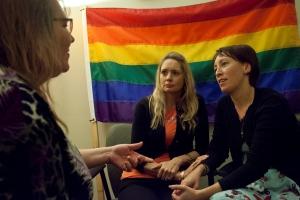Why I Needed to See a Queer Therapist (And How You Can Find One, Too)

My Personal Experience With Therapy as a Queer Person
When I first started therapy, I assumed any licensed professional would be able to help. But after a few sessions, I realized I was spending most of the time explaining my identity instead of talking about what was actually hurting me. Questions like “So, what does pansexual mean again?” made me feel unseen and even more isolated.
That’s when I realized: I didn’t just need therapy. I needed a queer therapist.
The first time I sat down with someone who already understood LGBTQ identities, pronouns, chosen families, and the challenges of coming out, I felt a sense of relief. Instead of defending who I was, I could focus on healing. That shift changed everything for me.
Why LGBTQ-Affirming Therapy Matters
Research shows that LGBTQ people face higher rates of depression, anxiety, and trauma than the general population, often due to stigma and discrimination (NAMI, APA). While many therapists are supportive, there’s a difference between being “open-minded” and being truly affirming.
Working with therapists for LGBTQ clients offers:
-
Cultural competency: No need to explain basic concepts like gender identity or queer relationships.
-
Safe space: A place where your identity is validated, not questioned.
-
Evidence-based care: Many LGBTQ-affirming therapists use approaches like CBT (Cognitive Behavioral Therapy), DBT (Dialectical Behavior Therapy), or trauma-informed therapy tailored to queer experiences.
-
Community connection: Referrals and insights from someone who knows the resources available to LGBTQ clients.
How to Find Therapists for LGBTQ People
If you’re ready to start your own journey, here are some steps that worked for me (and can work for you):
-
Search LGBTQ-friendly directories
-
Psychology Today’s LGBTQ+ Therapist Directory
-
TherapyDen
-
Local LGBTQ centers often maintain referral lists.
-
Ask the right questions
Examples: -
“What is your experience working with LGBTQ clients?”
-
“Are you trained in gender-affirming or trauma-informed care?”
-
Consider representation
Some people feel more comfortable working with a queer therapist themselves, while others simply want someone who is affirming and well-trained. -
Explore online therapy
Many therapists for LGBTQ clients now offer virtual sessions, making it easier to find someone who’s the right fit, even if they’re not in your city. -
Trust your instincts
If you don’t feel safe or understood, it’s okay to move on and try someone else. Therapy is about you — your comfort matters.
Building Trust With the Right Therapist
For me, the turning point came in one session when my therapist said:
“You don’t need to justify your identity here. Let’s focus on what you want to heal.”
That sentence lifted a weight off my shoulders. It showed me that therapy isn’t just about coping — it’s about growing in a space where you’re fully seen.
This is the difference that working with therapists for LGBTQ people can make.
Final Thoughts
If you’re considering therapy, remember: you deserve more than just a supportive ear — you deserve care that sees, understands, and affirms all of you. Finding therapists for LGBTQ clients isn’t about being picky. It’s about protecting your mental health and creating space for true healing.
Therapy changed my life once I found the right fit. It can change yours too.
Author Bio
Written by Anjna Champaneri, a queer-identifying mental health advocate passionate about making therapy more accessible and inclusive. With lived experience navigating the challenges of finding affirming care, [Your Name] shares resources and insights to help LGBTQ individuals find therapists who truly understand.
- Art
- Causes
- Crafts
- Dance
- Drinks
- Film
- Fitness
- Food
- الألعاب
- Gardening
- Health
- الرئيسية
- Literature
- Music
- Networking
- أخرى
- Party
- Religion
- Shopping
- Sports
- Theater
- Wellness


